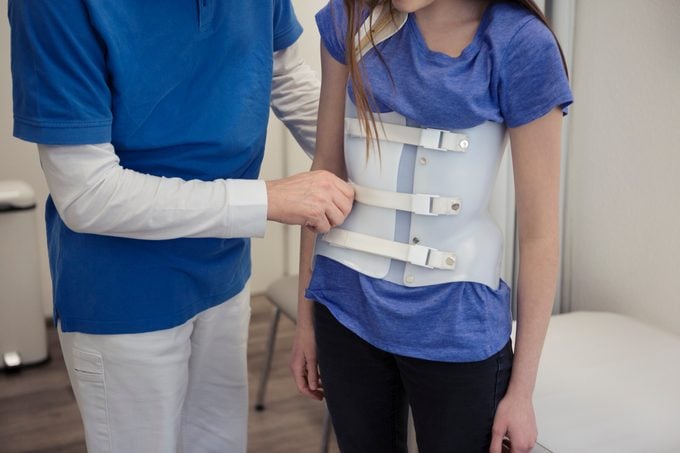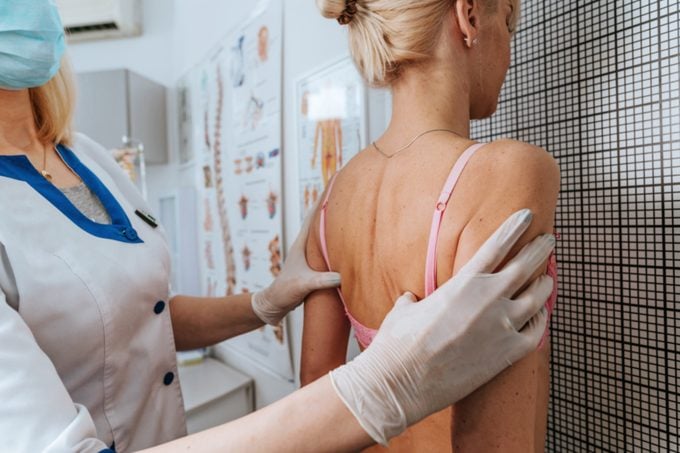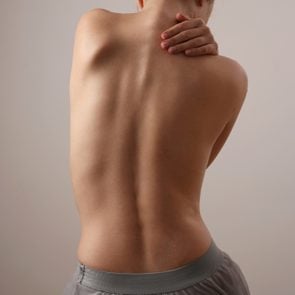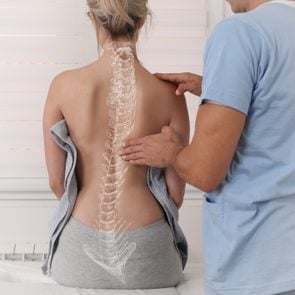What Is Scoliosis? A Guide to Symptoms, Treatments, and More
Updated: Aug. 24, 2021
Here's what you need to know about scoliosis, including the symptoms, causes, and treatments.
On This Page
What is scoliosis?
The spine, or your backbone, is made up of 33 stacked bones, called vertebrae that protect your spinal cord and give you the flexibility to bend, stretch, and move.
When viewed in profile, the spine usually has a gentle, S-shaped curve. When all is well, the spine allows you to do everything from stretch and bend your neck to reach down to tie your shoes.
However, some people—about two to three percent of the population—have a a spine that has a lateral curvature, according the American Association of Neurological Surgeons.
This curvature is called scoliosis, and while sometimes it’s mild and barely noticeable, it can be more severe or cause pain or other problems.
Dominick Tuason, MD, a pediatric orthopaedic surgeon specializing in spinal issues at Yale Medicine, explains that when viewed from the back, most spines will appear straight on an x-ray.
However, the spine of a person with scoliosis has a side-to-side curve that looks more like an S or a C when viewed from the back.
“These curves can make the person’s shoulders, hips or waist appear uneven,” he says.
In scoliosis, the spine’s vertebrae may also rotate, causing one shoulder blade or trunk muscles to be more prominent than the other.
What are the degrees of curvature?
The Cobb Method, a measure of the spine’s curvature, is used to identify scoliosis.
Dr. Tuason explains that the degree of the curve determines the severity of scoliosis or whether it is mild, moderate, or severe.
| Scoliosis Degrees of Curvature Chart | |
| Scoliosis type | Degree of curvature |
| Spinal asymmetry | A curvature that measures less than 10 degrees from the top of the curvature to the bottom |
| Mild scoliosis | A curve that measures anywhere between 11-24 degrees |
| Moderate scoliosis | A curve that measures between 25-45 degrees |
| Severe scoliosis | Any curve greater than 45 degrees |
Spinal asymmetry
A curvature that measures less than 10 degrees from the top of the curvature to the bottom is technically not scoliosis, but rather is defined as spinal asymmetry.
Mild scoliosis
A curve that measures anywhere between 11-24 degrees is mild scoliosis.
Moderate scoliosis
A curve that measures between 25-45 degrees is generally moderate.
Severe scoliosis
Any curve greater than 45 degrees is generally severe.
Who does scoliosis affect?
Both children and adults can develop scoliosis.
“Most frequently in children, scoliosis develops during the growth spurt preceding puberty,” Dr. Tuason states.
In adults, scoliosis that initially developed during childhood can worsen or develop as the spine undergoes degenerative changes that occur as a person ages.

What are the types of scoliosis?
There are three main types of scoliosis.
Idiopathic scoliosis
In more than 80 percent of scoliosis cases, a specific cause is not known.
“Although the exact cause has not been determined in a large number of cases, studies have been done which help us understand things that do not cause scoliosis,” says Dr. Tuason.
Unlike some other spinal issues, scoliosis does not result from carrying heavy items, sports, poor posture, or minor leg length abnormalities.
When the cause is unknown, it’s called idiopathic (meaning of undetermined cause) scoliosis, and these cases are most common in adolescent girls.
- Infantile idiopathic scoliosis is in children ages 0 to 3.
- Juvenile idiopathic scoliosis is in children ages 4 to 10.
- Adolescent idiopathic scoliosis is in adolescents ages 11 to 18.
- Adult idiopathic scoliosis is in patients older than 18.
Neuromuscular scoliosis
Less often, scoliosis develops in those diagnosed with other conditions.
People with cerebral palsy (CP), spinal muscle atrophy (SMA), Angelman syndrome, Arnold-Chiari malformation/syrinx, or trauma to the spinal cord may develop neuromuscular scoliosis.
Syndromic or genetic scoliosis
Syndromic scoliosis means that the curvature is related to other genetic or non-genetic diseases, conditions, or syndromes.
- Myopathic (muscular system-related) disorders like muscular dystrophy, poliomyelitis, arthrogryposis or spina bifida
- Connective tissue diseases (Marfan syndrome and Ehlers-Danlos syndrome)
- Genetic conditions (osteochondrodystrophy [dwarfism], Noonan syndrome, neurofibromatosis), and certain syndromes related to multiple birth defects like VATER syndrome
What are the symptoms?
Oftentimes, scoliosis can be completely asymptomatic.
This explains why it is not uncommon for moderate curvatures to go unnoticed until a school nurse or pediatrician does a scoliosis check during a routine well-child examination.
“In some instances, scoliosis can cause back pain,” explains Dr. Tuason.
Symptoms of scoliosis vary slightly for children and adults, according to the Scoliosis Research Society.
Adolescents
- Crooked shoulders—one is higher than the other
- The head does not seem centered, or it is slightly tilted to one side
- One of the shoulder blades seems to “stick out” more than the other
- The person seems to lean to one side
- One of the legs seems longer than the other
- One of the hips “juts out” more than the other
- The rib cage seems uneven or crooked—one side “sticks out” more than the other, or there’s a “rib hump” on one side of the back when leaning over
Adults
Idiopathic scoliosis symptoms
Due to degeneration of discs and joints, adults with idiopathic scoliosis have more symptoms than teens, according to the Scoliosis Research Society.
Those symptoms include:
- Low back pain and stiffness
- Numbness, cramping, and shooting pain in the legs due to pinched nerves
- Fatigue resulting from strain on the muscles of the lower back and legs
Degenerative scoliosis symptoms
This type of degenerative scoliosis is in the lumbar spine (lower back).
It is the most common form of adult scoliosis, occurring in about 38 percent of adults, and is more prevalent in women and people over 60 years of age.
It’s caused by a degeneration of the intervertebral discs, which results in a side-to-side spinal curve.
These discs, which are like spongy cushions that separate the vertebrae and act like shock absorbers, tend to naturally wear out with aging.
This type of scoliosis can cause:
- Back pain
- Numbness
- Shooting pain down the legs

How is scoliosis diagnosed?
Diagnosis of scoliosis starts with a physical exam.
“You stand in a relaxed position with your arms at your sides, and the doctor will view you from behind looking for curvature of the spine, shoulder blade asymmetry, waistline asymmetry, and any trunk shift,” explains Dr. Tuason.
You would also bend forward at the waist to allow the doctor to observe the rotation of the spine.
“Scoliosis can create a rib prominence in the upper back and/or a flank or waist prominence in the lower back, because of rotation of vertebral bodies when there is a curve in the spine,” he says.
If scoliosis is suspected following this simple examination, the doctor will usually order x-rays of the entire spine from the neck to the pelvis (back and side views).
What are the treatment options?
Treatment options include routine monitoring of the curvature, and in some cases, physical therapy, as long as it remains minimal, wearing a brace to try to stop the curve(s) from progressing, or surgery for patients with major curves causing discomfort or other health problems, explains Dr. Tuason.
Mild scoliosis
In mild cases of scoliosis, regular clinic visits and x-ray examinations at various times help monitor the curve’s behavior and development.
Doctors will keep an eye out for worsening or progression of the scoliosis. Should the curve progress, or if the curve is larger, treatment may be appropriate.
During this observation period, treatments such as scoliosis-specific physical therapy—like specific scoliosis stretches—may be recommended.
In addition, some studies suggest that optimizing vitamin D intake may help minimize the potential for curve worsening, he says.
Moderate scoliosis
Moderate cases in children who are still growing are generally treated with a back brace to help prevent worsening of the curvature, in combination with scoliosis-specific physical therapy.
“The general expectation is that these treatment modalities will slow or prevent worsening of the scoliosis but will not correct the curvature that is already present,” says Dr. Tuason.
Severe scoliosis
Patients with severe scoliosis may consider surgery to correct the curve.
“Surgery consists of either a corrective procedure where the spine is fused after screws and rods are used to correct the curve or a fusionless procedure, like vertebral body tethering, where screws and a flexible tether, or cord, is used to straighten the spine,” he says.
(These are the other scoliosis treatments to know.)
Living with scoliosis
Unfortunately, scoliosis doesn’t go away on its own.
“Generally, the curves in a spine with scoliosis can’t be reversed or cured without surgery,” explains Dr. Tuason.
“The goal of wearing a brace or doing physical therapy is to stop the curve from getting bigger, not to cure scoliosis.”
However, the long-term prognosis of living with scoliosis is generally excellent.
“Physical activity is beneficial to kids with scoliosis,” he notes.
“Therefore, unless you are in pain or your doctor gives you instructions to the contrary, you should continue to participate in the activities and sports you love—even if you wear a brace,” Dr. Tuason says.
“In fact, keeping your core trunk strong is good for your back.”
Additionally, considering your condition when purchasing items such as mattresses for scoliosis or desk chairs can also help manage pain related to the condition.



